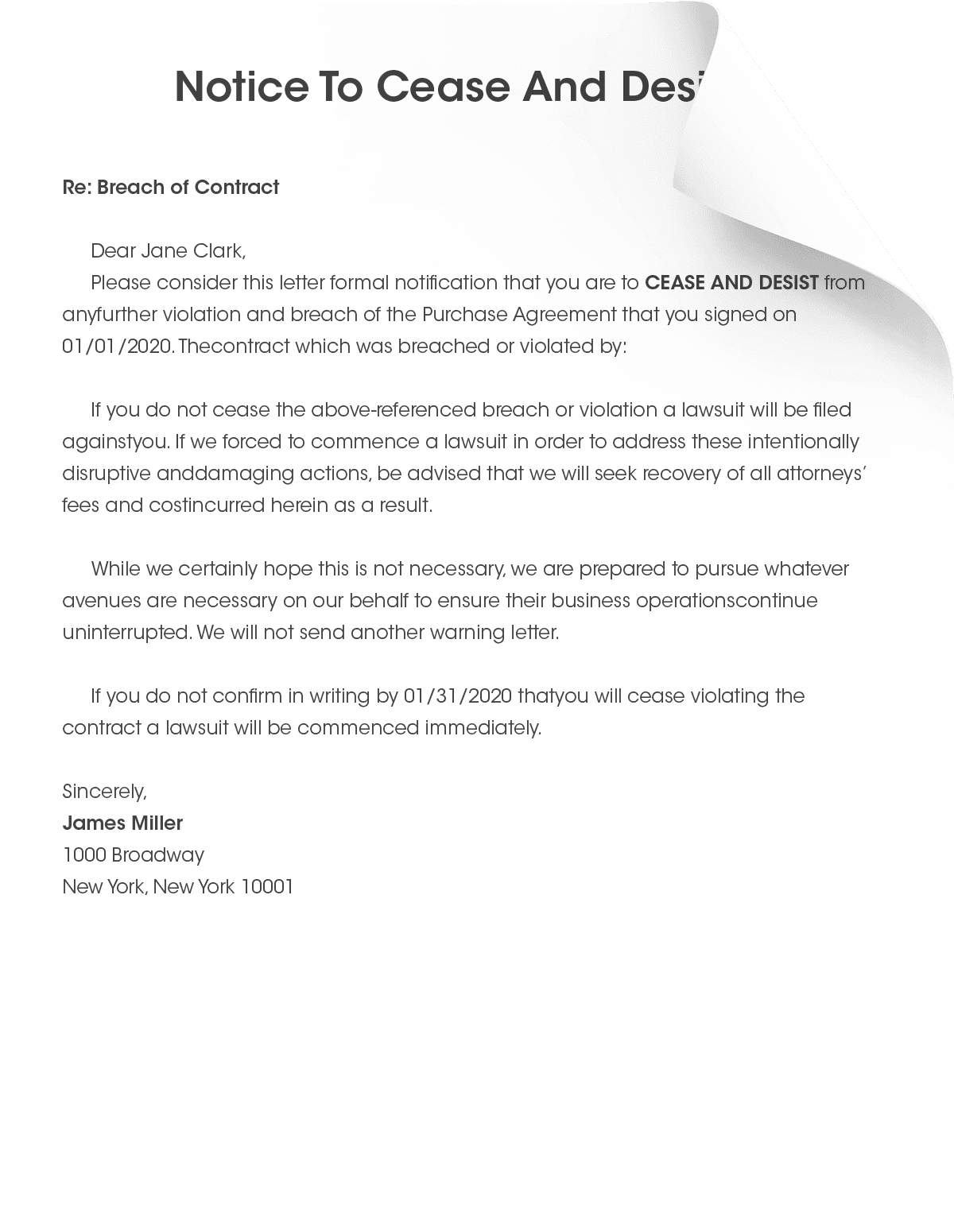What is a Cease and Desist Letter?

You send a cease and desist letter to an individual or entity to make them stop a continued action immediately. It’s often used for contract breaches, like employment agreements. The letter addresses breaches of valid agreement covenants by the other party. Maybe you’re wondering: “what is a cease and desist letter”? It’s essentially a formal request to stop specific actions and avoid further legal consequences.
These letters serve as an official warning that if the offending party does not halt the behavior in question, legal action may follow. A cease and desist letter can be used in various situations beyond breach of contract. Such cases involve intellectual property infringement, defamation, harassment, or violations of confidentiality agreements. By issuing this letter, the sender aims to protect their rights while giving the recipient an opportunity to correct the issue without immediately resorting to litigation.
Using a cease and desist letter template ensures that all the necessary details are included and presented in a professional, legally sound format. Templates help structure the letter and clearly state your concerns. This structure minimizes the risk of leaving out important information, which could weaken the letter’s impact.
Moreover, a cease and desist letter can help preserve relationships between parties by resolving disputes amicably. The letter serves as a middle ground before escalating to a lawsuit.
Why Do You Need to Use a Cease and Desist Letter?
A cease and desist letter is typically used to put the breaching party on notice of their violation or breach. It also puts the breaching party on notice that if they do not cease the activity, a lawsuit will follow. This letter acts as a preventive measure that can potentially save both parties the time and cost associated with legal proceedings.
In addition, sending this letter may avoid the need for a formal cease and desist order, which requires court involvement. While an order carries legal weight enforced by the court, a well-drafted letter can often resolve the issue without that added step. By acting early with a free cease and desist letter, you demonstrate your intention to enforce your rights without incurring unnecessary legal expenses.
A cease and desist letter can also help to create a record of your efforts to address the issue. This documentation can be valuable if the dispute progresses to court, showcasing your attempts to mitigate damages before filing a lawsuit. It highlights the importance of acting in good faith and gives the recipient a chance to comply voluntarily.
Furthermore, the letter establishes clear boundaries and expectations. For example, in employment disputes, issuing a cease and desist letter for non-compete or confidentiality breaches underscores the seriousness of contract terms. This often deters further violations and reinforces the integrity of contractual agreements.
When Do You Need to Use a Cease and Desist Letter?

A breach of contract cease and desist letter should be sent when the other party breaches any part of the contract. It’s a “last resort” option and serves as final notice to the breaching party that if they fail to comply with the letter, legal action will be commenced.
- For instance, if an employee violates a non-compete clause by joining a competitor or if confidential information is leaked, this breach can severely harm the business. A cease and desist order may eventually be required if the initial letter does not resolve the issue. However, by using a free cease and desist letter as a preliminary step, the chances of escalating to court are minimized.
- Cease and desist letters are also commonly used in intellectual property disputes. If someone uses copyrighted materials, trademarks, or patents without permission, a cease and desist letter can prompt them to stop unauthorized use. This action can prevent further financial losses and reputational damage.
Are There Any Deadlines or Times When a Cease and Desist Letter is Needed?
As soon as the other party is in breach, it is crucial to prepare a cease and desist letter. Continued violations could accumulate more damages. Once you are aware of the breach, you have a duty to mitigate damages and notify the other party of the breach. This allows them an opportunity to mend before proceeding in the courts.
Timing is critical because allowing the violation to persist without addressing it can weaken your case in court. Legal doctrines often require the aggrieved party to take prompt action to minimize harm. By acting swiftly with a cease and desist letter, you demonstrate a proactive approach to resolving the issue. If you are unsure as to whats a cease and desist, think of it as your first step in legally addressing a violation without immediately going to court. This approach not only helps reduce potential damages but also signals to the opposing party that you are prepared to defend your interests if necessary.
What Are the Main Things That Go in a Cease and Desist Letter?
The breach of contract cease and desist letter should include:
- The date you intend to mail it. Sending it via certified mail is critical to prove your efforts to mitigate damages and allow the breaching party an opportunity to cure.
- The type of contract breached, such as employment agreements or confidentiality clauses.
- The date the contract was signed by the parties. Include a copy of the executed contract and a description of the breach (e.g., nonpayment, breach of non-compete, non-performance).
- A deadline for the recipient to respond before further action is taken.
A well-drafted cease and desist letter template can help ensure you cover all these essentials. It removes guesswork and standardizes the letter’s format, making the process straightforward.
What Are the Most Common Mistakes to Avoid?

Creating an effective cease and desist letter requires attention to detail and a professional approach. Avoiding these common mistakes can help ensure your letter serves its intended purpose:
Failing to Send the Letter via Certified Mail
One of the most critical errors is not sending the cease and desist letter via certified mail. Certified mail provides proof of delivery, confirming the recipient received the letter and the date it was sent. This documentation is invaluable if you need to file a complaint in court, as it demonstrates your valid attempt to address the issue before pursuing legal action.
Using an Unprofessional or Aggressive Tone
While it’s important to convey seriousness, being overly aggressive or bullying can harm your case and escalate tensions. A professional tone helps set the stage for an amicable resolution and demonstrates that your primary goal is to avoid lengthy and costly litigation.
Failing to Provide Key Details
Your letter should be clear and thorough. Include the following essential elements:
- A deadline for the recipient to respond, ensuring they understand the urgency of the matter.
- Your contact information, making it easy for them to reach out for clarification or negotiation.
- If applicable, attach a copy of the relevant contract to highlight the specific breach in question. This reinforces the legitimacy of your claims and clarifies the issue at hand.
By avoiding these mistakes, you can craft a compelling cease and desist letter that not only strengthens your case but also improves the likelihood of resolving the issue without legal intervention.
Create Your Cease and Desist Letter Easily and Securely
You don’t need to hire a lawyer, accountant, or notary to create a professional cease and desist letter. By using our cease and desist letter template, you can simplify the process and ensure your document is clear, complete, and legally sound. Our platform makes it easy to generate a free cease and desist letter in minutes, tailored to your specific needs.
FormPros offers a fast, efficient, and user-friendly process, allowing you to download your document immediately after answering a few simple questions. If adjustments are needed later, you can easily revisit and edit your letter at any time. If you’re still wondering “what is a cease and desist letter?”, our platform guides you through every step to ensure clarity and effectiveness.
Why choose FormPros? Our tool is designed to eliminate mistakes and provide legally binding documents that protect your interests. With advanced encryption, your data is secure and private. Plus, we stand by our product with a 100% money-back guarantee.
Key Features of Form Pros:
- Easy to Use
- Eliminate Mistakes
- 100% Private & Secure
- Legally Binding Documents
- 100% Money-Back Guarantee
Don’t wait to take action—create your cease and desist letter today with FormPros.
Create a Cease and Desist Letter Now
Simplify your paperwork with FormPros! From creating paystubs, W-2s, and 1099-MISC forms to generating LLC Operating Agreements and even voided checks, our easy-to-use platform has you covered. Save time, reduce errors, and handle your business documents with confidence. Start now and see how FormPros makes professional form generation fast, affordable, and hassle-free!
Cease and Desist Letter FAQs
-
What is the difference between a cease and desist letter and a cease and desist order?
- A cease and desist letter is an informal, non-binding legal document sent to request that someone stop certain actions.
- A cease and desist order, on the other hand, is a legally binding directive issued by a court or government authority, enforceable by law.
-
Can a cease and desist letter be sent without a lawyer?
Yes, you can draft and send a cease and desist letter without a lawyer. However, using a template or seeking legal advice ensures the letter is properly structured and legally sound.
-
How should I respond if I receive a cease and desist letter?
If you receive a cease and desist letter, review the claims carefully, gather any supporting documentation, and consult a lawyer to determine how to respond appropriately. Ignoring the letter could lead to legal action.
-
What happens if the recipient ignores a cease and desist letter?
If the recipient ignores the letter, the sender may escalate the matter by filing a lawsuit or seeking a formal cease and desist order from a court.
-
Can I use a cease and desist letter for verbal harassment or threats?
Yes, you can send a cease and desist letter for verbal harassment or threats to formally request the behavior to stop and create a record of your efforts to address the issue.
-
Is a cease and desist letter legally enforceable?
No, a cease and desist letter is not legally enforceable on its own. However, it serves as a formal warning and can be used as evidence in court to show that you attempted to resolve the issue before taking legal action.
-
How long should I give the recipient to respond to a cease and desist letter?
The response time can vary, but a typical deadline is 7 to 14 days. This gives the recipient enough time to review the claims and take corrective action if necessary.
-
Can a cease and desist letter be used in personal disputes, like between neighbors?
Yes, a cease and desist letter can be used in personal disputes, such as addressing noise complaints, property boundary issues, or harassment by a neighbor.
-
Do I need to include evidence in a cease and desist letter?
While it's not mandatory, attaching evidence such as copies of contracts, correspondence, or documented incidents strengthens your claims and provides clarity to the recipient.
-
What should I do if I’m unsure about writing a cease and desist letter?
If you're unsure about drafting a cease and desist letter, consider using a professionally designed template or consulting an attorney. This ensures that your letter includes all essential details and is legally sound.





